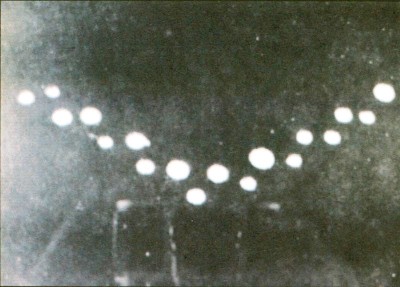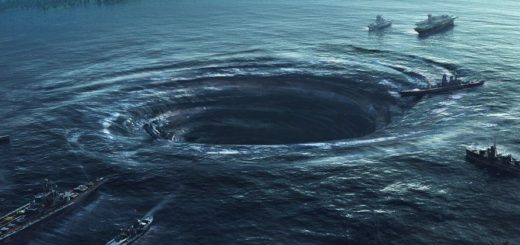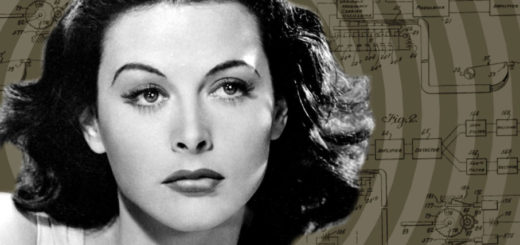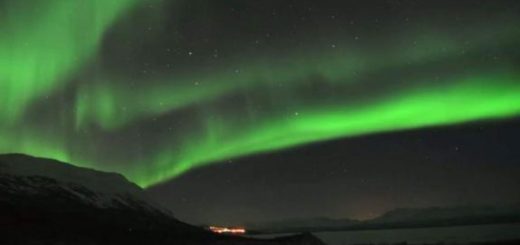UFO Classification

J. Allen Hynek classified UFO reports into six categories: nocturnal lights, daylight discs, radar/visual cases, close encounters of the first kind, close encounters of the second kind, and close encounters of the third kind.
Nocturnal lights. Near midnight on the evening of August 30, 1951, during a spate of sightings of boomerang-shaped lights in Lubbock, Texas, college student Carl Hart, Jr., glimpsed a formation of 18 to 20 white lights through his bedroom window. Forming a perfect V configuration in two rows, they were passing silently over his parents’ house from the north. Grabbing a 35mm camera, Hart raced outside, hoping they would return. A minute later the lights reappeared, and though they were visible for less than five seconds, he was able to snap two pictures. When the lights returned once more, Hart got three more pictures.
The local newspaper as well as the Air Force subjected Hart’s photographs of the “Lubbock lights” — as they are known in UFO lore — to intensive investigation. No evidence of a hoax emerged then or later, and no conventional explanation could be found.
FORTEAN PICTURE LIBRARY
Daylight discs. From mid-morning to mid-afternoon on July 8, 1947, silvery disc-shaped objects bedeviled Muroc Air Base (later renamed Edwards AFB). Two discs first showed up at 9:30 A.M; they moved at 300 miles per hour at 8,000 feet altitude on a level flight path against the wind. A third disc, flying in tight circles, then appeared and headed toward the Mojave Desert with the first two. Some 40 minutes later a test pilot warming up an XP-84 aircraft saw another object, again flying into the wind. At noon, as a pilot was conducting a seat-ejection test at 20,000 feet, observers saw a UFO underneath it. The object was descending rapidly; it then headed north. Witnesses told Air Force investigators that “it presented a distinct oval-shaped outline, with two projections on the upper surface which might have been thick fins or knobs. They crossed each other at intervals, suggesting either rotation or oscillation of a slow type. . . . The color was silver, resembling an aluminum-painted fabric.” At 4 P.M. an F-51 pilot encountered a “flat object of a light-reflecting nature” without wings or fins.
These sightings, Hynek wrote, caused the Air Force to “take a deep interest in UFOs.”
Radar/visual. While driving east of Corning, California, near midnight on August 13, 1960, state police officers Charles Carson and Stanley Scott saw a lighted object drop out of the sky. Fearing the imminent crash of an airliner, they screeched to a halt and jumped out of their car. The object continued to fall until it reached about 100 feet altitude, at which point it abruptly reversed direction and ascended 400 feet, then stopped. “At this time,” Carson wrote in his official report, “it was clearly visible to both of us. It was surrounded by a glow making the round or oblong object visible. At each end, or each side of the object, there were definite red lights. At times about five white lights were visible between the red lights. As we watched, the object moved again and performed aerial feats that were actually unbelievable.”
The two officers radioed the Tehama County Sheriff’s Office and asked it to contact the nearest Air Force base (at Red Bluff). Radar there confirmed the object’s presence.
The UFO remained in view for more than two hours. During that time two deputy sheriffs and the county jailer saw it from their respective locations. According to Carson:
On two occasions the object came directly towards the patrol vehicle; each time it approached, the object turned, swept the area with a huge red light. Officer Scott turned the red light on the patrol vehicle towards the object, and it immediately went away from us. We observed the object use the red beam approximately six or seven times, sweeping the sky and ground areas. The object began moving slowly in an easterly direction and we followed. We proceeded to the Vina Plains Fire Station where it was approached by a similar object from the south. It moved near the first object and both stopped, remaining in that position for some time, occasionally emitting the red beam. Finally, both objects disappeared below the eastern horizon.
Carson noted, “Each time the object neared us, we experienced radio interference.”



 Creators of mankind
Creators of mankind Description of “Tall white aliens”
Description of “Tall white aliens” Where they came from?
Where they came from? About hostile civilizations
About hostile civilizations The war for the Earth
The war for the Earth “Tall white aliens” about eternal life
“Tall white aliens” about eternal life Video: “Nordic aliens”
Video: “Nordic aliens” Aliens
Aliens Alien encounters
Alien encounters The aliens base
The aliens base UFO
UFO Technology UFO
Technology UFO Underground civilization
Underground civilization Ancient alien artifacts
Ancient alien artifacts Military and UFO
Military and UFO Mysteries and hypotheses
Mysteries and hypotheses Scientific facts
Scientific facts


















